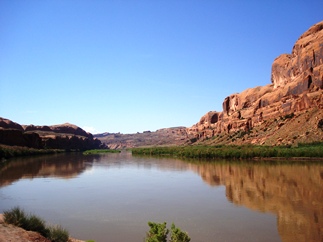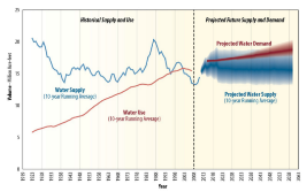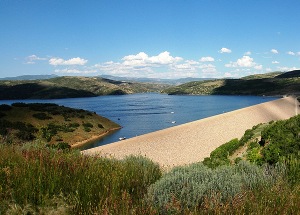Colorado River Challenges
Interior Secretary Salazar tells Colorado River Water Users Association members that the demand on the river could outstrip supply by 3.2 MAF by the year 2060 according to a recently completed Reclamation study.
February 8, 2013
LeRoy W. Hooton, Jr.
Figure 1. The Colorado River near Moab, Utah. The river provides Utahns recreational, environmental, power generation and water supplies for agriculture, municipal and industrial benefits.

(Las Vegas, NV) - Interior Secretary Ken Salazar told a gathering of the Colorado River Water Users Association that they can expect a continuation of droughts within the Colorado River basin. “As I speak to you today, the past 12 year period has been the driest period of record for one-hundred plus years within the Colorado River basin … and there is no clear sign that we are at the end of [this] drought,” he said.
Buttressing the intensity of the basin drought, he said that tree ring data reveal that this dry period (2000 – 2012) is the most severe experienced during the last 1,000 years. “Based on models, we will continue to see these kinds of droughts into the future,” he warned.
Salazar foreboded that the people and ecological resources along the river will suffer from drought, requiring serious dialog and investments to cope with this growing problem. Currently the Colorado River and its tributaries provide water to nearly 40 million people for municipal uses and irrigation water for nearly 5.5 million acres of land in the Southwest states. It also provides water for 22 tribes within the basin. Hydropower facilities along the Colorado River have generating capacity of more than 4,200 megawatts of electrical power. The United States also has Colorado River international treaty obligations under a 1944 treaty with Mexico.
|
Compounding the problems emerging on the Colorado River are the effects of climate change. “It is undeniable that climate change and its emerging challenges will have major consequences on the river,” said Salazar. Models indicate a 9 percent reduction in river flows, and in the worst case as much as 30 percent reduction in river flows by 2060. This added to an over-appropriated river by one-million acre-feet and a growing population assures enormous stresses on the Colorado River and its environs into the future.
Salazar stressed the necessity for cooperation among the stakeholders to develop a long term management plan for the river. He discouraged “endless litigation and congressional fights,” by the stakeholders and to “cooperate” as a means of resolving the challenges facing the Colorado River into the future. He praised the Colorado River water users for being a working model of collaboration in their ability to resolve issues as communities that are connected by the river.
In an effort to address the challenges of the Colorado for the next 50 years the Colorado River Basin Water Supply and Demand Study was undertaken by the Bureau of Reclamation and representatives of the Basin States’ agencies in collaboration with all of the stakeholders. It was funded by Interior’s Water Smart Initiative (Sustain and Manage America’s Resources for Tomorrow).
Described by Salazar as the most comprehensive study ever done, its purpose is to define current and future imbalances in water supply and demand in the Basin and the adjacent areas of the Basin States that receive Colorado River water through 2060; and to develop and analyze adaptation and mitigation strategies to resolve those imbalances.
The results of the Study were released on December 12 at the beginning of the Colorado River Water Users Association conference and a session of the meeting was devoted to presentations on the various aspects of the final report. The Study projected an annual water supply deficit of 3.2 MAF by 2060.
Chosen to head the Study, Bureau of Reclamation employee Kay Brothers told the conference attendees that the Study was a collaborative effort with all of the stakeholders represented. Taking three years, the Study consumed thousands of hours of work to complete. She stressed that it was a planning study, not a decisional document – there were no concrete recommendations on what should be pursued or implemented. “It’s a technical foundation for discussion as we move to the next phase of the study,” she said.
|
The Study also includes a wide array of adaptation and mitigation strategies proposed by stakeholders and the public to address the projected imbalances.
The Study report provided 150 potential options to reduce the water deficit ranging from easily attainable ones to others that are dubious at best. It explored a wide range of options with the goal of ensuring that all viable options were at least considered.
Many of the options are already being used such as reuse, desalination, conservation and efficiency measures and these options only need to be intensified. “The Study will create a paradigm in which the stakeholders can collaborate together to find solutions,” said Salazar, who doubted that importing water from the Mississippi River or floating icebergs to the West coast were viable options today; but adaptions over the next 50 years may make them feasible options.
The options are classified into 4 groups: 1) increase supply, 2) reduce water demand, 3) modify operations and 4) focus on governance and mechanisms to facilitate option implementation.
According to the Study, the total options contained in all the groups generate a potential yield of approximately 5.7 MAF per year by 2035 and more than 11 MAF per year by 2060. However, these estimates are expected to be much lower after the options are subjected to closer scrutiny and actual implementation.
Salazar noted that there is a lot of work ahead to solve the challenges on the Colorado River, and “the Study provides the framework to transform the challenges of today for opportunities tomorrow,” he said.

